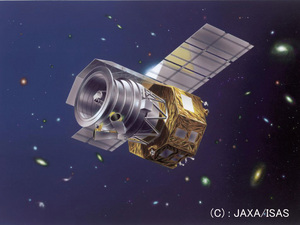Nagoya City Science Museum
TOP > Exhibition Guide > Floor Map> Infrared Astronomy
Infrared Astronomy



Purpose of Exhibition
Objects with temperatures from 3000 to 3 degrees Kelvin emit infrared radiation, mainly in the wavelength range of 1 to 100μm. So, infrared astronomy is especially good for studying astronomical phenomena at relatively low temperatures in the Universe.
This exhibit displays the prototype model of the infrared astronomy satellite AKARI, and will show you its ingenuities for and results of infrared observations.
Additional Knowledge
What are the ingenuities of the satellite AKARI?
[Ingenuities for Infrared Observation]
The basic structure of an infrared telescope is the same as that of a visible light telescope. The mainstream of infrared telescopes is a reflective optical system that collects infrared light with a reflector. Now, objects at room temperature always emit strong infrared radiation; the telescopes themselves or the atmosphere which is transparent to visible light are no exceptions. In order to control these backgrounds and catch the faint infrared light from astronomical objects, we need ingenuities such as cooling down the observational device or the chopping method where we rapidly vibrate the secondary mirror, observe the object and the nearby sky alternately, and measure the difference. Besides, long-wavelength infrared radiation does not reach the ground, so we can observe only the near-infrared region with high resolution in ground-based observations.
AKARI has a remarkable cryogenic system combined with liquid helium cryogen and mechanical two-stage Stirling coolers, and chills a telescope and instruments to very low temperature of -270 degrees Celsius so as to reduce its own thermal radiation to a minimum. The telescope and devices were on the ground stored in the cryostat, a vacuum vessel with an aperture lid to maintain appropriate thermal conditions. The aperture lid was opened and jettisoned in space after the launch, and observations started.
And also, AKARI has a sunshield to protect the telescope from the sun’s powerful radiation and prevent sunlight from striking the inside.
Although the telescope could not be made larger due to the payload capacity of the rocket, those ingenious devices enable AKARI to make highly sensitive observations free from its own thermal emission, as well as blurring caused by the earth's atmosphere.
[Operation of the AKARI Satellite and its Accomplishments]
The AKARI satellite was launched on February 22, 2006 by an ISAS M-V rocket, injected into a sun synchronous orbit at an altitude of about 700km, and started observations in May of the same year.
AKARI ran out of the liquid helium cryogen on August. Even after the exhaustion AKARI still continued observations, chilling the telescope only by the mechanical cooler. Finally, the AKARI satellite was shut down on November 24, 2011, and all operations were completed.
The AKARI mission and its survey data have yielded a great and wide range of astronomical achievements, including new discoveries about the mechanisms of planet formation and active star formation in galaxies, and moreover, unravelling the history of the Universe. They have also produced and released “The AKARI All-Sky Survey Point Source Catalogues,” a collection of no less than 1.3 million infrared sources, and “Asteroid catalog using AKARI (AcuA)”, which comprises more than 5,000 asteroids.
This page was last edited on 15 June 2022.
Article by Astronomy Section
